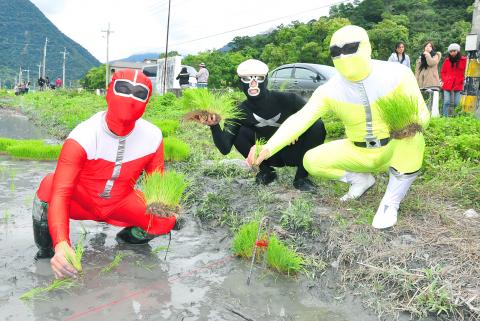A series of activities will take place throughout Taiwan to mark the one-year anniversary of Japan’s March 11 earthquake and tsunami, including events to show Japan’s gratitude for Taiwan’s disaster relief efforts, a Japanese official stationed in Taipei said.
A reception will be held tomorrow in Taipei to thank Japan’s “Taiwanese friends” and bring them up to date on reconstruction following the disaster, Interchange Association, Japan, Secretary-General Kenichi Okada said.
The association represents Japanese interests in Taiwan in the absence of official diplomatic ties between the two nations.

Photo: CNA
Japanese Representative to Taiwan Tadashi Imai is also running a notice in major Taiwanese newspapers today to express Japan’s gratitude for the aid and generous donations from the Taiwanese public, Okada said.
In the wake of the magnitude 9.0 earthquake and subsequent tsunami that battered northeastern Japan and led to a meltdown at the Fukushima Dai-ichi nuclear power plant, Taiwan donated about ¥20 billion (US$260 million) to the victims, 90 percent of which came from private donors.
Two television programs made to thank Taiwan for its help will also be broadcast on two channels in the coming week, Okada said, adding that a commercial thanking Taiwanese will be shown on several local stations.
Citing statistics that showed the number of Japanese visitors to Taiwan reached a record high last year, Okada said the record “just shows that Japanese really love Taiwan and feel grateful for Taiwan’s help.”
Okada, who assumed his post in August last year, said he was touched by the story of six Japanese swimmers who completed a 150km relay across part of the Pacific Ocean as a gesture of gratitude to Taiwanese.
In September last year, the swimmers battled rain and strong currents while a typhoon was approaching, Okada said.
Their determination to complete the swim under such difficult conditions “just proved how grateful the Japanese people are to Taiwan,” Okada said.
Meanwhile, today in Nantou County a foundation will host a series of events at the site of a paper dome from Japan to commemorate the anniversary of the earthquake and tsunami.
A concert, photo exhibition and other events will take place at the Newland Community Education Center in Puli Township (埔里), where the dome is located.
The dome, built from 58 giant cardboard columns, was moved in 2008 from Japan where it had served as a temporary church following the Kobe earthquake in 1995.
According to the New Homeland Foundation, which is organizing the event, the church serves to remind victims of disaster that they can become stronger if they stand united.
A prayer meeting was held at the dome following the disaster last year.
The foundation said Japanese harpist Rikako Fujioka, who held a fundraising concert in her country after an earthquake hit Taiwan on Sept. 21, 1999, will perform with her students and friends at the dome to thank Taiwanese for the concern they showed.
Photos of the disaster areas by Japanese photographer Satoshi Ueda, who lost his mother in the tsunami, will be shown at the dome until April 8 in an exhibition called “Tears of the Earth.”
Several Taiwanese artists will also take part in the commemorative activities by selling their works to raise money to help with reconstruction in the disaster-affected areas.

US climber Alex Honnold is to attempt to scale Taipei 101 without a rope and harness in a live Netflix special on Jan. 24, the streaming platform announced on Wednesday. Accounting for the time difference, the two-hour broadcast of Honnold’s climb, called Skyscraper Live, is to air on Jan. 23 in the US, Netflix said in a statement. Honnold, 40, was the first person ever to free solo climb the 900m El Capitan rock formation in Yosemite National Park — a feat that was recorded and later made into the 2018 documentary film Free Solo. Netflix previewed Skyscraper Live in October, after videos

Starting on Jan. 1, YouBike riders must have insurance to use the service, and a six-month trial of NT$5 coupons under certain conditions would be implemented to balance bike shortages, a joint statement from transportation departments across Taipei, New Taipei City and Taoyuan announced yesterday. The rental bike system operator said that coupons would be offered to riders to rent bikes from full stations, for riders who take out an electric-assisted bike from a full station, and for riders who return a bike to an empty station. All riders with YouBike accounts are automatically eligible for the program, and each membership account

NUMBERS IMBALANCE: More than 4 million Taiwanese have visited China this year, while only about half a million Chinese have visited here Beijing has yet to respond to Taiwan’s requests for negotiation over matters related to the recovery of cross-strait tourism, the Tourism Administration said yesterday. Taiwan’s tourism authority issued the statement after Chinese-language daily the China Times reported yesterday that the government’s policy of banning group tours to China does not stop Taiwanese from visiting the country. As of October, more than 4.2 million had traveled to China this year, exceeding last year. Beijing estimated the number of Taiwanese tourists in China could reach 4.5 million this year. By contrast, only 500,000 Chinese tourists are expected in Taiwan, the report said. The report

Temperatures are forecast to drop steadily as a continental cold air mass moves across Taiwan, with some areas also likely to see heavy rainfall, the Central Weather Administration (CWA) said. From today through early tomorrow, a cold air mass would keep temperatures low across central and northern Taiwan, and the eastern half of Taiwan proper, with isolated brief showers forecast along Keelung’s north coast, Taipei and New Taipei City’s mountainous areas and eastern Taiwan, it said. Lows of 11°C to 15°C are forecast in central and northern Taiwan, Yilan County, and the outlying Kinmen and Lienchiang (Matsu) counties, and 14°C to 17°C